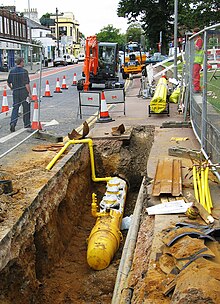Trench

A trench is a type of excavation or depression in the ground that is generally deeper than it is wide (as opposed to a wider gully, or ditch), and narrow compared with its length (as opposed to a simple hole).[1]
In geology, trenches are created as a result of erosion by rivers or by geological movement of tectonic plates. In the civil engineering field, trenches are often created to install underground infrastructure or utilities (such as gas mains, water mains or telephone lines), or later to access these installations. Trenches have also often been dug for military defensive purposes. In archaeology, the "trench method" is used for searching and excavating ancient ruins or to dig into strata of sedimented material.
Types and uses
Geology
Some trenches are created as a result of erosion by running water or by glaciers (which may have long since disappeared). Others, such as rift valleys or more commonly oceanic trenches, are created by geological movement of tectonic plates. Some oceanic trenches include the Mariana Trench and the Aleutian Trench. The former geoform is relatively deep (approximately 10 kilometres (6.2 mi)), linear and narrow, and is formed by plate subduction when plates converge.[2]
Civil engineering

In the civil engineering field of construction or maintenance of infrastructure, trenches play a major role. They are used to place underground easily damaged and obstructive infrastructure or utilities (such as gas mains, water mains or telephone lines). A similar use for higher bulk would be in pipeline transport. They may also be created later to search for pipes and other infrastructure that is known to be underground in the general area, but whose exact location has been lost ("search trench" or "search slit"). Finally, trenches may be created as the first step of creating a foundation wall. Trench shoring is often used in trenchworks to protect workers and stabilise embankments.
An alternative to digging trenches is to create a utility tunnel. The advantages of utility tunnels are the reduction of maintenance manholes, one-time relocation, and less excavation and repair, compared with separate cable ducts for each service. When they are well mapped, they also allow rapid access to all utilities without having to dig access trenches or resort to confused and often inaccurate utility maps. One of the greatest advantages is public safety. Underground power lines, whether in common or separate channels, prevent downed utility cables from blocking roads, thus speeding emergency access after natural disasters such as earthquakes, hurricanes, and tsunamis. For a comparison of utility tunnels vs. direct burial, see the article referred to above.
In some cases, a large trench is dug and deliberately preserved (not filled in), often for transport purposes. This is typically done to install depressed motorways, open railway cuttings, or canals. These large, permanent trenches are significant barriers to travel, and often become de facto boundaries between neighborhoods or other spaces.
Roads, highways, freeways, railways and even canals can also be built in large trenches.
Military engineering
Trenches have often been dug for military purposes. In the pre-firearm era, they were mainly a type of hindrance to an attacker of a fortified location, such as the moat around a castle (this is technically called a ditch). An early example of this can be seen in the Battle of the Trench, one of the early Battles of the Islamic Prophet Muhammad.[3]
With the advent of accurate firearms, trenches were used to shelter troops. Trench warfare and tactics evolved further in the Crimean War, the American Civil War and World War I, until systems of extensive main trenches, backup trenches (in case the first lines were overrun) and communication trenches often stretched dozens of kilometres along a front without interruption, and some kilometres further back from the front line.
-
Allied troops entrenched in the Battle of Tuyutí
-
Soldiers in a trench during the Gallipoli Campaign of World War I
-
The Boer trench at the Battle of Magersfontein contributed to the surprise defeat of the Highland Brigade on 11 December 1899 during the Second Boer War.
Archaeology

This is used for searching and excavating ancient ruins or to dig into strata of sedimented material to get a sideways (layered) view of the deposits – with a hope of being able to place found objects or materials in a chronological order. The advantage of this method is that it destroys only a small part of the site (those areas where the trenches, often arranged in a grid pattern, are located). However, this method also has the disadvantage of only revealing small slices of the whole volume, and modern archeological digs usually employ combination methods.[4]
See also
References
- ^ Code of Federal Regulations, Title 29, Volume 8, Page 374 (Code revised as of July 1, 2003, via Compliance Magazine's website) Archived June 2, 2007, at the Wayback Machine
- ^ Ocean trench (glossary from Student Resource Center website, Houghton Mifflin college division)
- ^ Sa'd, Ibn (1967). Kitab al-tabaqat al-kabir. Vol. 2. Pakistan Historical Society. pp. 82–84. ASIN B0007JAWMK.
- ^ Archaeology – People! Magazine, Winter 1998
External links
- Trenching and Excavation (a NIOSH Safety and Health Topic, Centers for Disease Control and Prevention)
- Trench Safety Awareness (a NIOSH Publication, Centers for Disease Control and Prevention)



